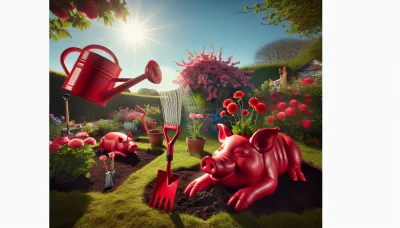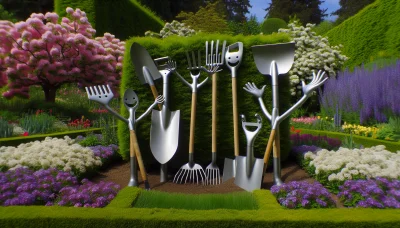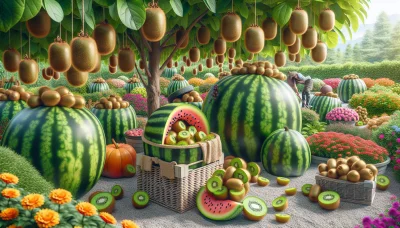Durian flower Quiz
Test Your Knowledge
Question of
Introduction to Durian Flower
Durian flowers play a pivotal role in the cultivation of durian fruit, a delicacy cherished in many parts of the world for its distinctive taste and aroma. These flowers are significant in gardening and agriculture because they are the precursors to the durian fruit. The process of pollination of these flowers directly impacts the fruit's quality and yield. Understanding the blooming cycle, the environmental conditions required for optimal flowering, and the methods for encouraging pollination can greatly enhance durian production. Gardeners and farmers pay close attention to the health and development of durian flowers to ensure a bountiful harvest of this unique and valuable fruit.
Understanding Durian Flower Biology
The durian, known for its distinctive smell and taste, has a fascinating flower biology that plays a crucial role in its growth cycle. Durian flowers are large and white, blooming directly from the trunk and older branches of the tree in a process known as cauliflory. This unique trait allows for easier access by their primary pollinators, which include bats and certain insects. The flowers open late in the afternoon and into the night, releasing a strong, pungent odor that attracts these nocturnal pollinators. Each bloom lasts for a brief period, typically around one to two nights, after which pollination occurs if successful.
Following pollination, the development of the durian fruit begins, taking around three to four months to mature. The flowers themselves are hermaphroditic but are functionally male at the beginning of the flowering period, becoming female later on. This sequential hermaphroditism reduces self-pollination and encourages genetic diversity among the durian population. The growth cycle and unique characteristics of durian flowers are essential for the reproduction of the durian tree, ensuring the continuation of this species that is so culturally and economically significant in many parts of Southeast Asia.
How to Grow Durian Flowers
- Select a suitable location that receives ample sunlight and has well-draining soil.
- Ensure the soil pH is slightly acidic, ideally between 5.5 and 6.5.
- Plant durian seeds or saplings during the warm, rainy season to facilitate growth.
- Water the plants regularly, keeping the soil consistently moist but not waterlogged.
- Apply a balanced fertilizer every three to four months to provide essential nutrients.
- Prune the tree carefully to maintain its shape and remove any dead or diseased branches.
- Protect the plants from pests and diseases by using organic pesticides and fungicides.
- Be patient, as durian trees take several years to mature and produce flowers.
Common Challenges in Growing Durian Flowers
Growing durian flowers can be a rewarding yet challenging experience for gardeners. One of the most common issues faced is the lack of proper pollination, which is crucial for fruit development. This problem can often be mitigated by ensuring the presence of natural pollinators in the garden or by manually pollinating the flowers. Another significant challenge is the susceptibility of durian flowers to fungal diseases, particularly during the humid season. To combat this, gardeners should ensure good air circulation around the plants and apply fungicides when necessary. Additionally, durian trees require well-drained soil to thrive; waterlogged conditions can lead to root rot and other health problems for the plant. Implementing proper drainage solutions in the garden can help overcome this issue. Lastly, durian flowers need a specific range of temperatures to bloom successfully, which can be difficult to achieve in non-tropical climates. Utilizing greenhouse technologies or choosing a suitable microclimate within the garden can help in creating an environment conducive for their growth.
Benefits of Durian Flowers in Your Garden
Durian flowers, beyond their association with the famously polarizing fruit, offer a myriad of benefits when incorporated into your garden. Ecologically, these flowers are a boon for biodiversity; they attract a wide range of pollinators, including bees and bats, which are crucial for the pollination of many plants and the overall health of your garden. Aesthetically, durian flowers are visually striking. Their large, white, candelabra-like blooms stand out against the green foliage, adding an exotic and tropical flair to any garden setting. The presence of durian flowers can transform your garden into a lush, vibrant, and ecologically thriving space.
Durian Flower Pollination and Fruit Production
The pollination process of durian flowers is a fascinating and crucial step in the production of durian fruit. Durian trees produce large, nocturnal flowers that emit a strong odor to attract specific pollinators, primarily bats and, to a lesser extent, certain species of birds and insects. These pollinators visit the flowers for their nectar and, in the process, transfer pollen from the male parts of one flower to the female parts of another, enabling fertilization. Once fertilized, the flowers gradually develop into the large, spiky durian fruits known for their distinctive smell and taste. This intricate relationship between durian flowers and their pollinators highlights the importance of biodiversity and ecosystem health in the cultivation of this unique fruit.
FAQs on Durian Flowers
- What is the best season for durian flowers to bloom?
- How often should durian flowers be watered?
- What are the ideal conditions for growing durian flowers successfully?
- Are there any specific fertilizers recommended for durian flowers?
- How can I protect durian flowers from pests and diseases?
- What is the typical lifespan of a durian flower before it turns into fruit?
- Can durian flowers bloom indoors?
- How do I ensure cross-pollination for durian flowers?
- What are the common challenges in cultivating durian flowers and how can they be overcome?
- Are there any tips for encouraging more blooms from durian trees?












